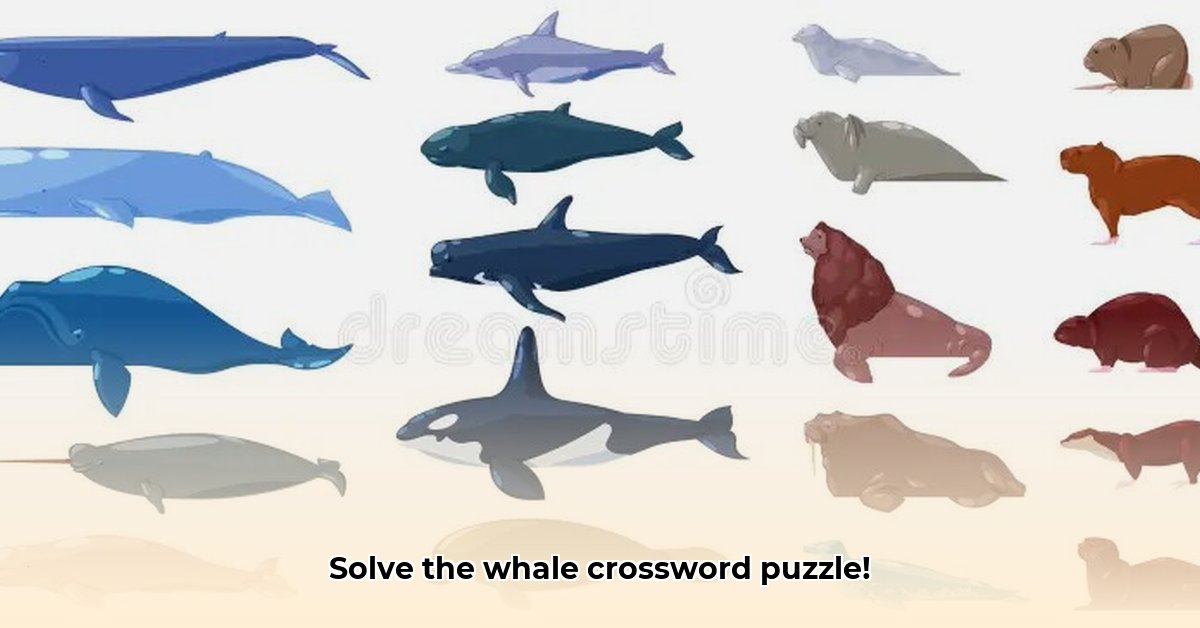
Walvisachtig Zoogdier: Navigating the Nuances of Dutch Crossword Clues
Ever found yourself stumped by a Dutch crossword clue referencing a walvisachtig zoogdier (whale-like mammal)? These clues, while seemingly straightforward, often present a unique challenge. This guide explores the complexities of cetacean nomenclature within the context of Dutch crossword puzzle design, offering strategies to unlock even the trickiest clues. We’ll examine common issues, explore effective solving techniques, and consider how to improve the accuracy and engagement of future puzzles.
The Broad Spectrum of "Whale-Like": Beyond the Obvious
The term walvisachtig zoogdier encompasses a wide range of marine mammals, including whales, dolphins, and porpoises (cetaceans). However, crossword compilers sometimes take liberties with the definition. A manatee (zeekoe in Afrikaans), for instance, shares a superficial resemblance to whales, yet belongs to a different order (sirenians). This highlights a crucial aspect: crossword clues prioritize solvability and accessibility, often sacrificing strict scientific accuracy.
The Crossword Compiler's Conundrum: Solvability vs. Scientific Precision
Popular Dutch crossword resources like Puzzelwoordenboek and Mijnwoordenboek frequently favour brevity. "Orca" becomes "orka," "sperm whale" simplifies to "potvis." This enhances puzzle solvability, but this simplification sometimes compromises scientific accuracy. Consider the numerous dolphin species: a crossword likely asks for "dolphin" (dolfijn), instead of detailing the specific species, demanding only general knowledge.
Inconsistencies and the Art of Interpretation
The inherent inconsistencies in how cetaceans are represented across different Dutch crosswords highlight a dynamic tension. One puzzle might include the "zeepaard" (seahorse), not even a mammal, while another might omit well-known whales like humpbacks. This variability suggests a degree of creative licence. The game, it seems, is as much about interpretation as it is about precise knowledge.
A Data-Driven Approach to Understanding Crossword Cetaceans
To truly understand the representation of whale-like mammals in Dutch crosswords, systematic analysis is required. Consider a comparative study of Puzzelwoordenboek and Mijnwoordenboek, examining factors such as:
Word Length: How often are shorter words used, versus longer, more scientifically precise terms? We'd anticipate a prevalence of shorter words, prioritising ease of solving.
Scientific Accuracy: To what extent do clues employ precise scientific names instead of common names? Common names are likely to dominate for easier comprehension.
Database Consistency: Do both dictionaries utilize the same terms for the same cetaceans? Discrepancies are probable, reflecting individual puzzle-makers' choices.
Spelling and Capitalisation: Are there inconsistencies in spelling or capitalisation that could confuse solvers? This is plausible and could lead to ambiguity.
Crosswords and Scientific Literacy: A Broader Perspective
This investigation transcends simple puzzle-solving. It reveals how we communicate and understand scientific concepts. The simplification of complex scientific terms for the sake of puzzle design suggests a form of shorthand for scientific knowledge. This raises questions: does simplification always lead to better understanding, or does it sometimes compromise accuracy?
How to Enhance Cetacean Naming in Dutch Crossword Puzzles
Let's explore practical strategies to improve the representation of cetaceans in Dutch crossword puzzles, balancing accuracy with the demands of puzzle design.
Strategies for Improved Accuracy and Engagement
Expand the Species Range: Move beyond common whales and dolphins. Introduce lesser-known species, using both Dutch common names and scientific names where appropriate, enriching the puzzle's educational value.
Employ Contextual Clues: Rather than generic clues, utilise descriptive phrases. For example, instead of "Arctic whale," use "Arctic whale with a long tusk" (narwhal) for a more specific and engaging clue.
Harness Multilingual Wordplay: Leverage the richness of the Dutch language, utilizing cognates from other languages or incorporating Dutch idioms related to cetaceans.
Incorporate Visual Clues (where possible): Images or illustrations (where space allows) can significantly improve understanding and engagement, especially for less familiar species.
Foster Collaboration: Collaboration between crossword compilers and marine biologists ensures both scientific accuracy and engaging puzzle design.
Analysing Existing Clues: A Case Study
Consider the vague clue "Zoogdier van de oceaan met een lange snuit" (Ocean mammal with a long snout). This lacks specificity. A revised clue, "Zoogdier met een lange snuit, bekend van de Noordelijke IJszee" (Mammal with a long snout, known from the Arctic Ocean), directly points to a narwhal.
Data-Driven Refinement: Towards a More Accurate Future
Imagine compiling a database monitoring the frequency of different cetacean species across Dutch crosswords. Such data could reveal biases, guiding future puzzle design towards greater diversity and accuracy. Analysing successful and unsuccessful clues can provide valuable insights for future puzzle creation.
Key Takeaways:
- Greater diversity in species representation is needed in Dutch crossword clues.
- Contextual clues significantly enhance accuracy and solver engagement.
- Multilingual wordplay adds a unique and valuable dimension to Dutch puzzles.
- Visual aids, where feasible, can greatly improve understanding and solver success.
- Collaboration between puzzle creators and marine biologists is crucial.